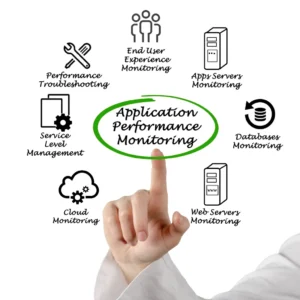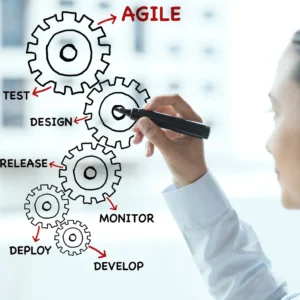
Unlock success with Intelligent Process Automation
A comprehensive guide to adoption strategies
Embarking on the transformative journey of Intelligent Process Automation (IPA) demands a strategic roadmap. This comprehensive guide navigates organisations through a spectrum of crucial concepts, from initial process mapping to continuous improvement.
Technological infrastructure, data management, bot development, and cognitive automation are thoroughly investigated. The orchestration of user interface and experience, compliance, security, and scalability lay the foundation for agile methodologies and vendor selections.
As the symphony of adoption strategies unfolds, organisations gain insights into cost-benefit analysis, documentation, and iterative enhancements, ensuring that IPA becomes a dynamic catalyst for sustained success in an ever-evolving business landscape.
Unlocking Efficiency in IPA Adoption
Business process analysis is the foundation of Intelligent Process Automation (IPA) adoption strategies. It involves scrutinising operations to identify inefficiencies and areas for improvement. By dissecting workflows, organisations gain a holistic understanding of their processes, paving the way for targeted enhancements.
Process discovery is the next crucial step, revealing hidden intricacies within operations. Through advanced technologies, businesses can unearth hidden bottlenecks and discover automation opportunities. This phase is pivotal in aligning automation efforts with the organisation’s needs.
Process optimisation follows, where identified inefficiencies are addressed and streamlined. Intelligent Process Automation aims to enhance productivity and reduce redundancies. This stage focuses on refining existing processes, ensuring the automation implementation aligns seamlessly with the overarching business goals.
Equally important is process documentation, providing a detailed record of workflows. Clear documentation is fundamental for successful IPA implementation, ensuring a smooth transition and facilitating ongoing improvements. It serves as a reference point for troubleshooting and future optimisations.
As we delve into the intricate world of IPA adoption strategies, the next concept to explore is the foundational “Technological Infrastructure.” How can organisations structure their technological backbone to support robust Intelligent Process Automation?
Building Blocks: Technological Infrastructure
Intelligent Process Automation cannot be complete without Machine Learning (ML) at its core. The magic ingredient turns regular automation into something brilliant and remarkable. ML algorithms analyse data patterns, enabling systems to learn and make intelligent decisions. Integrating ML into the technological framework enhances the adaptability and responsiveness of automated processes.
Artificial Intelligence (AI) amplifies automation capabilities. By mimicking human cognitive functions, AI-powered systems excel in complex decision-making. Organisations leverage AI within their infrastructure to infuse sophistication that significantly elevates process automation effectiveness.
Natural Language Processing (NLP) brings a human touch to automation by enabling machines to understand and interpret human language. This technology enhances communication between systems and users, fostering a more intuitive and user-friendly automation experience.
Data integration is paramount for cohesive automation. Siloed data can hinder the effectiveness of Intelligent Process Automation. Integrating data from various sources ensures a comprehensive and unified view, empowering automation processes with accurate and real-time information.
API connectivity forms the backbone of seamless interactions between different software applications. Robust API integration facilitates smooth data exchange, enabling diverse systems to work harmoniously. This connectivity is crucial for the success of Intelligent Process Automation strategies.
As we delve into the intricate realm of technological infrastructure, the next vital concept to explore is “Data Management.” How can organisations efficiently manage and leverage data to optimise their Intelligent Process Automation initiatives?
Data Harmony: Essential Components
Data quality is the bedrock of successful automation. Ensuring accurate, consistent, and reliable data is vital for Intelligent Process Automation. Organisations must implement robust mechanisms to cleanse and maintain the quality of their data, laying a solid foundation for automation initiatives.
Data security is paramount to safeguard sensitive information. Intelligent Process Automation relies on vast amounts of data, making it imperative to establish stringent security measures. Encryption, access controls, and secure data transmission protocols are crucial elements in protecting valuable organisational data.
Effective data governance is essential for orchestrating the entire data lifecycle. Organisations need clear policies and procedures to ensure data accountability, compliance, and proper management. Well-defined governance structures facilitate responsible data use and minimise risks associated with automation processes.
Data extraction is a pivotal step in acquiring relevant information for automation. Intelligent Process Automation relies on the seamless extraction of data from various sources. Streamlining this process ensures that automation processes get accurate and timely data for optimal performance.
Data validation is the final checkpoint in the data journey. Organisations must implement robust validation processes to verify the accuracy and integrity of the data used in automation. Rigorous validation mechanisms enhance the reliability of automation outputs and contribute to overall process efficiency.
Having established the importance of data management, the next focal point in Intelligent Process Automation Adoption Strategies is “Bot Development.” How can organisations effectively design and deploy intelligent bots to streamline automated processes?
Automating Excellence: Bot Development
Bot design is the cornerstone of effective Intelligent Process Automation. Creating well-structured bots involves defining tasks, workflows, and interactions. Thoughtful design ensures bots align seamlessly with organisational processes, maximising efficiency.
Scripting is the language of automation. Bots rely on scripts to execute tasks accurately and efficiently. Mastery of scripting languages is crucial for developers to craft automation scripts that effectively translate business logic into automated actions.
Bot testing is a critical phase in the development process. Rigorous testing validates bot functionality, identifying and rectifying any errors. Thorough testing ensures the reliability and precision of automated processes, minimising disruptions in real-world scenarios.
Version control is essential for managing bot updates and changes. Establishing a version control system allows developers to track modifications, revert to previous versions if necessary, and maintain a stable and well-documented bot development environment.
Error handling is a fundamental aspect of robust bot development. Intelligent Process Automation is not immune to errors, and effective error-handling mechanisms ensure graceful recovery and minimise disruptions. Thoughtful error handling contributes to the resilience and reliability of automated processes.
Having explored the intricacies of bot development, the next frontier in Intelligent Process Automation Adoption Strategies is “Cognitive Automation.” How can organisations harness the power of cognitive technologies to elevate their automation initiatives to new heights?
Elevating Automation: Cognitive Automation
Decision-making algorithms mark the pinnacle of cognitive automation. These advanced algorithms empower systems to make complex decisions by analysing data patterns, significantly enhancing the decision-making capabilities of automated processes. Strategic implementation of decision-making algorithms is critical to unlocking the full potential of Intelligent Process Automation.
Predictive analytics adds a forward-looking dimension to automation. By leveraging historical data and statistical algorithms, predictive analytics enables systems to forecast future trends and outcomes. This foresight enhances the adaptability of automated processes, allowing organisations to proactively address challenges and capitalise on opportunities.
Pattern recognition is the cognitive skill that enables systems to identify and interpret patterns within vast datasets. In the context of Intelligent Process Automation, pattern recognition enhances the efficiency of automated processes by allowing systems to discern meaningful information and trends.
Intelligent document processing is a cornerstone of cognitive automation, enabling systems to comprehend and extract valuable information from unstructured documents. This capability streamlines data input processes, contributing to the overall effectiveness of automated workflows.
As we unravel the capabilities of cognitive automation, the next dimension to explore in Intelligent Process Automation Adoption Strategies is “User Interface (UI) and User Experience (UX).” How can organisations optimise user interaction and automated systems to enhance the efficiency and satisfaction of their processes?
Seamless Interaction: Optimising UI/UX
Human-in-the-loop (HITL) integration is essential for a harmonious interface. This approach combines machine automation with human oversight, ensuring a balanced synergy. HITL allows human intervention when needed, providing flexibility and oversight in automated processes.
User acceptance testing (UAT) is the litmus test for system usability. Before full deployment, UAT gauges how well the system aligns with user needs. Rigorous testing ensures the interface meets user expectations, paving the way for a smooth and successful adoption of Intelligent Process Automation.
User training is pivotal for a smooth transition to automated processes. Organisations must invest in comprehensive training programs to equip users with the necessary skills. Adequate training fosters user confidence, reducing resistance to change and facilitating a more seamless integration of Intelligent Process Automation.
User feedback is a continuous improvement catalyst. Establishing feedback mechanisms allows users to provide insights into the system’s usability. Organisations can leverage this input to refine the interface, ensuring that Intelligent Process Automation aligns with evolving user needs and preferences.
Having explored the user-centric aspects, the next crucial dimension in Intelligent Process Automation Adoption Strategies is “Compliance and Security.” How can organisations ensure that automated processes adhere to regulatory standards and maintain the highest levels of data security?
Guardians of Integrity: Compliance and Security
Regulatory compliance is the cornerstone of trustworthy automation. Adhering to industry regulations ensures that automated processes align with legal standards. Robust compliance frameworks safeguard organisations from legal repercussions and instil confidence in stakeholders.
Audit trails provide transparency in automation journeys. Documenting every action and decision ensures a comprehensive record. These trails support regulatory compliance and serve as valuable tools for internal reviews, enhancing accountability and facilitating continuous improvement.
Access controls are the gatekeepers of sensitive data. Implementing strict access policies ensures that only authorised personnel can interact with specific information. This layer of security is vital in protecting confidential data and preventing unauthorised access to automated processes.
Encryption shields data from prying eyes. Employing robust encryption mechanisms secures data during transmission and storage. This safeguard is essential for maintaining the confidentiality and integrity of information processed through Intelligent Process Automation.
GDPR considerations are paramount in today’s data-centric landscape. Organisations must navigate the intricacies of the General Data Protection Regulation to ensure that automated processes respect individuals’ privacy rights. Following GDPR principles builds trust and fosters a positive relationship between organisations and their users.
Having fortified the foundations of compliance and security, the next horizon in Intelligent Process Automation Adoption Strategies is “Scalability and Integration.” How can organisations ensure their automation initiatives are scalable and seamlessly integrated into their evolving business landscapes?
Seamless Growth: Scalability and Integration
Scalability planning is the compass for future growth. Organisations must anticipate and accommodate increased demands on automated processes. Thoughtful scalability planning ensures that Intelligent Process Automation can seamlessly adapt to evolving business needs without disruptions.
System integration is the linchpin of efficiency. Ensuring that automated processes integrate seamlessly with existing systems enhances overall operational cohesion. System integration streamlines data flow and communication, fostering a unified and interconnected organisational ecosystem.
Legacy system compatibility is crucial for continuity. Many organisations still rely on legacy systems, and Intelligent Process Automation must coexist harmoniously with these technologies. Compatibility ensures a smooth transition, preserving the value of existing investments while leveraging the benefits of automation.
Cloud integration empowers flexibility and accessibility. Integrating Intelligent Process Automation with cloud platforms enhances scalability and provides a centralised data storage and processing environment. Cloud integration facilitates remote access and collaboration, fostering a dynamic and adaptable automation landscape.
As organisations fortify their Intelligent Process Automation with scalability and integration strategies, the next crucial aspect to explore is “Change Management.” How can organisations effectively manage and navigate the cultural and procedural changes associated with adopting automated processes?
Navigating Transformation: Change Management
Stakeholder communication is the bedrock of successful change management. Open and transparent communication with all stakeholders fosters understanding and buy-in. Keeping stakeholders informed about the objectives and benefits of Intelligent Process Automation builds a positive foundation for change.
Change readiness assessment gauges organisational preparedness. A thorough evaluation identifies potential challenges and resistance to change. Targeted strategies can address concerns and ease the transition to automation.
Training programs are the catalysts for skill transformation. Implementing comprehensive training initiatives equips employees with the skills needed to navigate the new automated landscape. Well-designed programs build confidence, reduce apprehension, and enhance adaptability to change.
Change monitoring and adaptation are continuous processes. Tracking the impact of automation on operations and culture allows organisations to make necessary adjustments. Proactive monitoring ensures that change strategies remain effective, fostering a culture of continuous improvement.
As organisations embark on the transformative journey of Intelligent Process Automation, the next dimension to explore is “Performance Monitoring and Analytics.”
Performance Monitoring and Analytics
Key performance indicators (KPIs) quantify success. Establishing relevant KPIs allows organisations to measure the effectiveness of Intelligent Process Automation. Whether throughput, accuracy, or cost savings, KPIs provide tangible metrics to gauge the impact of automation on business objectives.
Analytics dashboards offer visual insights. Dashboards aggregate data into comprehensible visuals, enabling stakeholders to grasp performance trends at a glance. User-friendly dashboards facilitate informed decision-making, fostering a data-driven culture within the organisation.
Real-time monitoring ensures agility. Continuous observation of automated processes in real-time allows organisations to respond swiftly to any issues or bottlenecks. Real-time insights empower quick decision-making and maintain the efficiency of automated workflows.
Continuous improvement is a dynamic mindset. Organisations use performance analytics to identify areas for enhancement. A commitment to constant improvement ensures that Intelligent Process Automation evolves in tandem with changing business needs.
Stakeholder communication remains pivotal. Regularly communicating performance insights to stakeholders fosters transparency and trust. Clear communication ensures that all stakeholders are informed and aligned with the progress and benefits of automation.
As organisations delve into the analytics-driven world, the next crucial dimension to explore in Intelligent Process Automation Adoption Strategies is “Vendor Selection.” How can organisations effectively choose the right vendors to support their automation initiatives and maximise the benefits of Intelligent Process Automation?
Strategic Alliances: Vendor Selection
Vendor evaluation is the foundation of success. Thoroughly assessing vendors ensures compatibility with organisational needs. Evaluation criteria may include expertise, reputation, and the ability to provide tailored solutions for Intelligent Process Automation.
Solution providers drive automation success. Choosing reputable providers with a proven track record enhances the likelihood of a successful implementation. Expertise, industry knowledge, and a robust portfolio of solutions are critical factors in selecting a reliable automation partner.
Licensing models shape cost structures. Understanding and selecting appropriate licensing models impact budgeting and scalability. Whether subscription-based, usage-based, or a one-time purchase, aligning licensing with organisational needs ensures a cost-effective and sustainable partnership.
Support and maintenance are ongoing commitments. Assessing the quality of support and maintenance services is crucial for long-term success. An efficient and dependable support structure is essential for ensuring the seamless operation of Intelligent Process Automation.
It enables swift resolution of any issues that may arise, thus reducing the potential for any interruptions in the workflow. A responsive support system ensures prompt addressing of concerns, maximising the benefits of Intelligent Process Automation. A reliable support structure assures minimal disruptions and optimal performance.
Having established the importance of strategic vendor selection, the next critical step in Intelligent Process Automation Adoption Strategies is “Cost-Benefit Analysis.” How can organisations meticulously assess the costs and benefits of automation to make informed decisions about their investments?
Strategic Investments: Cost-Benefit Analysis
Return on Investment (ROI) measures success. Calculating the ROI of Intelligent Process Automation allows organisations to quantify the benefits against the costs. A positive ROI validates the strategic value of automation, demonstrating tangible gains in efficiency, productivity, and cost savings.
Total Cost of Ownership (TCO) unveils the complete financial picture. Beyond initial expenses, TCO accounts for the complete cost spectrum, including implementation, maintenance, and potential upgrades. A comprehensive TCO assessment ensures a realistic view of the long-term financial implications of automation.
Cost analysis dissects financial components. Detailed cost analysis involves breaking down expenses into categories and clarifying investments. This granular understanding enables organisations to optimise spending and allocate resources efficiently.
Budgeting is the roadmap for financial success. Developing a well-structured budget aligns financial resources with automation goals. Strategic budgeting anticipates expenses, preventing financial surprises and ensuring that the organisation is well-prepared for the financial aspects of Intelligent Process Automation.
As organisations navigate the financial landscape of automation, the next critical dimension in Intelligent Process Automation Adoption Strategies is “Agile Methodology.” How can organisations leverage agile approaches to ensure flexibility and adaptability in implementing and managing automated processes?
Dynamic Progress: Agile Methodology
Agile development ensures adaptability. Agile development’s iterative and incremental nature aligns with the dynamic requirements of Intelligent Process Automation. Organisations can swiftly respond to changes, allowing for continuous improvement and optimisation throughout the automation journey.
Sprint planning structures progress. Dividing the implementation into sprints, or short development cycles, allows for focused and manageable goals. Sprint planning ensures that each phase contributes meaningfully to the overall progress, promoting efficiency and flexibility in the automation process.
Iterative development refines outcomes. The iterative approach involves repeating cycles of development, testing, and refinement. This method allows organisations to enhance the automation solution progressively. Iterative development is integral to refining functionalities and addressing evolving business needs.
Agile project management orchestrates agility. Agile project management facilitates team collaboration, strategic task prioritisation, and real-time adjustments based on feedback.
As organisations embrace the agility of Intelligent Process Automation, the next critical dimension in the adoption strategies is “Documentation.” How can organisations balance agility with the need for comprehensive documentation to ensure transparency and knowledge transfer in the automation process?
Preserving Wisdom: Documentation
Implementation documentation captures the blueprint. Thorough documentation during implementation ensures a comprehensive record of the automation process. Detailed documentation provides a valuable reference for troubleshooting and future optimisations, from configurations to customisations.
Standard operating procedures (SOPs) guide operations, and creating clear and detailed SOPs is crucial for maintaining consistency in automated processes. SOPs serve as a manual for employees, offering step-by-step guidance on executing tasks within the automated framework.
Knowledge transfer secures institutional wisdom. This transfer of wisdom empowers teams to understand, adapt, and contribute to the ongoing success of Intelligent Process Automation.
Training materials empower users. Well-crafted training materials are essential for equipping users with the skills to interact with automated systems. Comprehensive training materials, including manuals and tutorials, foster user confidence and facilitate a smooth transition to automated workflows.
Having fortified the pillars of documentation, the next crucial aspect in Intelligent Process Automation Adoption Strategies is “Continuous Improvement.”
Evolving Wisdom: Feedback and Optimisation
Feedback loops sustain improvement. Establishing feedback mechanisms ensures ongoing communication and insights. Feedback loops provide a continuous source of information, allowing organisations to address issues promptly and make informed decisions for refinement.
Post-implementation review validates success. Conducting a comprehensive review post-implementation evaluates the effectiveness of Intelligent Process Automation. This critical assessment identifies achievements, areas for improvement, and lessons learned, guiding future automation endeavours.
Optimisation strategies refine performance. Crafting strategies for ongoing optimisation ensures that automated processes remain aligned with organisational goals. Organisations employ various techniques, from fine-tuning algorithms to revisiting business rules, to continually enhance the efficiency of Intelligent Process Automation.
Iterative enhancements fuel progress. Embracing an iterative approach to enhancements allows organisations to adapt to changing requirements. Iterative enhancements involve incremental improvements based on real-world usage and evolving business needs, fostering a culture of perpetual evolution.
As organisations delve into continuous improvement through documentation, the next pivotal aspect in Intelligent Process Automation Adoption Strategies is “User Feedback.” How can organisations harness user insights to drive meaningful enhancements and ensure automated processes resonate with user needs?
Conclusion: Mastering IPA Adoption
Organisations navigate a dynamic symphony of interconnected concepts in orchestrating Intelligent Process Automation (IPA) adoption strategies. Businesses begin a journey of technological infrastructure, data management, bot development, and cognitive automation through strategic process mapping. The nexus of user interface (UI) and user experience (UX) ensures a harmonious interaction, setting the stage for meticulous compliance and security considerations.
Navigating scalability, integration, and change management, organisations embrace agility through Agile Methodology. Vendor selection becomes a strategic alliance, paving the way for cost-benefit analysis and a judicious exploration of documentation’s pivotal role. The continuous feedback loop, post-implementation reviews, optimisation strategies, and iterative enhancements fine-tune the automation symphony.
The user’s crucial role is acknowledged, and vendors are carefully selected to reach the crescendo. The grand finale, a continuous loop of user feedback, documentation, and iterative enhancements, ensures that the symphony of Intelligent Process Automation resonates with organisational goals and adapts harmoniously to the ever-evolving business landscape. As organisations master this symphony, they unlock the full potential of Intelligent Process Automation, propelling them towards a future of unprecedented efficiency, innovation, and sustained success.
Related Articles
- Choosing the Right Automation Tool in 7 Steps
- A 9-Step Guide to IPA Implementation: Energise Your Operations
- Navigating the Roadblocks of IPA – The Top 9 Challenges
- AI in Intelligent Process Automation – Unleash the Power of AI
- 9 IPA Examples in Small-Scale Industries
- Power of Intelligent Business Process Automation – Efficiency
- AI Business Process Management: Unleashing the Power
- Business Process Management with AI Integration
- AI for Reengineering Business Processes
- Hyperautomation: Redefining BPM with AI
- The Role of AI in Business Process Modelling
- AI-driven Customer Onboarding – Unleash the Power of AI
- Effective Process mapping in Intelligent Process Automation
- Intelligent Process Automation Adoption – The Best Strategy Guide
- TechInfra in IPA: A Comprehensive Guide
- Elevating Intelligent Automation with Continuous Improvement
- Comprehensive Approach to Cost-Benefit Analysis in IPA
- Vendor Selection in IPA – Comprehensive Guide
- Implementing Agile in Intelligent Process Automation (IPA)
- Scalability and Integration in Intelligent Process Automation
- Cognitive Automation in IPA: Innovating Ethical Efficiency
- Mastering Symphony: Bot Development in IPA Unveiled
- UI/UX Mastery in IPA: Elevating Automation Experiences
- Compliance and Security in IPA – A Guide Ensuring Trust
- Impact of Performance Monitoring and Analytics in IPA
- Driving Success: Data Management in IPA
- Crucial Role: Documentation in IPA Triumph
- Optimizing IPA – Continuous Improvement Strategies









































